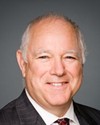No—
Evidence of meeting #4 for Finance in the 40th Parliament, 2nd Session. (The original version is on Parliament’s site, as are the minutes.) The winning word was advertising.
A recording is available from Parliament.
Evidence of meeting #4 for Finance in the 40th Parliament, 2nd Session. (The original version is on Parliament’s site, as are the minutes.) The winning word was advertising.
A recording is available from Parliament.
4:50 p.m.
Chief Financial Officer and Assistant Commissioner, Finance and Administration Branch, Canada Revenue Agency
No—
4:50 p.m.
Conservative
4:50 p.m.
Chief Financial Officer and Assistant Commissioner, Finance and Administration Branch, Canada Revenue Agency
It happens.... There was an earlier discussion around statutory items. The authority for this re-spending comes out of our statutes for the Canada Revenue Agency, so we need to put this disclosure in for information. That's why it is here.
4:50 p.m.
Conservative

Ted Menzies Conservative Macleod, AB
The next item is the private collection agencies. Are we seeing an increase in the cost of recovering taxes?
4:50 p.m.
Chief Financial Officer and Assistant Commissioner, Finance and Administration Branch, Canada Revenue Agency
This is actually a reduction. A few years ago we took over the responsibility for collection of Canada student loans from HRSDC. At the time, when they carried out that function, they made extensive use of private collection agencies. When we took over the responsibility, we found that we didn't need to resort to these to the same extent, because we were already a large collection agent.
During the government's strategic review process, we offered this as a reduction item, an efficiency item, and our proposal was accepted. So here we see the money coming out. This is money that was originally in the main estimates and it's now coming out to reflect our turning it back to the centre.
4:50 p.m.
Conservative

Ted Menzies Conservative Macleod, AB
On the softwood lumber export charges, are they in line, or did tariff rates change much over the year? I've honestly forgotten what this amount was last year.
4:50 p.m.
Chief Financial Officer and Assistant Commissioner, Finance and Administration Branch, Canada Revenue Agency
The amount in the supplementary estimates last year was $437 million. So it's in the same ball park this year. Essentially this is where the exporters pay the charge and then we disburse an amount, less our operating expenses, back to the provinces. So this just shows the amount of the payments, net of our expenses.
4:55 p.m.
Conservative

Ted Menzies Conservative Macleod, AB
I'm surprised it's that close, considering that we're exporting less lumber. Maybe the tariff percentage has changed.
Anyway, my colleague, Mr. Kerr, has a question.
4:55 p.m.
Conservative
4:55 p.m.
Conservative

Greg Kerr Conservative West Nova, NS
I'll have to rush.
Thank you, Mr. Chair.
I'm pleased to be replacing my colleague here, and I did come with a question, just out of curiosity.
I think the vice-chair gave me a bit of a segue by talking about whether the estimated cost of what you have available to look after the new savings program is going to be enough. From what I've heard, there's been a very successful start to the program. I would agree that if it's that successful, it is obviously going to cost a bit more to administer, and I assume that's what his question was leading to.
Can you give us some background on how the program is doing to date?
4:55 p.m.
Commissioner and Chief Executive Officer, Canada Revenue Agency
This program, of course, is just starting this year. For the last little while and on an ongoing basis, people can of course open up these tax-free savings accounts with more and more financial institutions. The requirement for reporting back to the CRA doesn't occur until the end of this year, in time for the next filing season.
Obviously, we've had a lot of questions from taxpayers. It seems to have been, as you indicated, something that's attracted quite a bit of attention. We've equipped our inquiries officers at the 1-800 number to be able to answer questions. We have materials that are published, and on our website, to help answer the obvious questions, as well as some of the ones that are less obvious. That's part of what this is all about. We believe it will be sufficient because much of the cost, as my colleague alluded to, is related to the infrastructure.
Generally in the CRA, once we have good operating infrastructure, the actual transactions themselves are a fairly modest incremental cost. It's just a matter of making sure that we can track all of this and give people an annual statement telling them the status of their tax-free savings account, and the ins and outs.
We've never done this before and we'll see how it all plays out. We have no experience with something like a tax-free savings account. Obviously, we've had experience with RRSPs, but this is quite a different vehicle and we'll learn as we go along.
If it turns out that the demands on the program are greater than we anticipated, that's something we would discuss with colleagues in the Department of Finance and Treasury Board.
4:55 p.m.
Conservative

The Chair Conservative James Rajotte
Thank you, Mr. Kerr.
We'll go to Mr. Julian, and you have seven minutes.
4:55 p.m.
NDP

Peter Julian NDP Burnaby—New Westminster, BC
Thank you very much, Mr. Chair. I would also like to thank the witnesses. Unfortunately, I missed your presentation.
I'm very interested in the softwood lumber export charges provided for in the Supplementary Estimates. Payments to communities that depend on softwood lumber will be reduced by $419 million.
How are the charges collected divided among the provinces? Do you have any figures that you can share with me?
4:55 p.m.
Chief Financial Officer and Assistant Commissioner, Finance and Administration Branch, Canada Revenue Agency
No. I don't have that with me, but we can certainly get it.
4:55 p.m.
Commissioner and Chief Executive Officer, Canada Revenue Agency
The only provinces affected are the ones that have ratified the agreement, and that includes British Colombia and a few others. However, we don't have the figures on how these charges are divided. If you wish, we could draw up a list for you showing the breakdown.
4:55 p.m.
NDP

Peter Julian NDP Burnaby—New Westminster, BC
I would be very interested in having that information. So then, you can't tell me how much revenue British Columbia, Quebec, Alberta or Ontario have lost. In the case of Saskatchewan and Manitoba, it is very likely that the penalties were paid at the border.
4:55 p.m.
Commissioner and Chief Executive Officer, Canada Revenue Agency
That's right.
4:55 p.m.
Chief Financial Officer and Assistant Commissioner, Finance and Administration Branch, Canada Revenue Agency
We can find that. We don't have that information with us, but that information is available. On the amount of the revenues, the amount of the export charge, and the amount of the transfer payments, we could provide further detail. We just don't have it with us today.
4:55 p.m.
NDP

Peter Julian NDP Burnaby—New Westminster, BC
In terms of the Agency's records, how does this work? If all of the charges are paid by the company, by the community...People work hard to produce a quality product that crosses the border. Pursuant to the agreement in place, the Government of Canada imposes a penalty. This revenue is transferred directly to the Agency which, in turn, transfers it to the provinces.
5 p.m.
Chief Financial Officer and Assistant Commissioner, Finance and Administration Branch, Canada Revenue Agency
Yes. Characterizing it as a penalty I'm not quite sure is appropriate.
5 p.m.
Chief Financial Officer and Assistant Commissioner, Finance and Administration Branch, Canada Revenue Agency
I believe it's called an export charge, and the revenue from the export charge is then shared.
5 p.m.
NDP

Peter Julian NDP Burnaby—New Westminster, BC
It is a simple double entry. The money comes in to the federal government agency and then it goes back to the province.
5 p.m.
Chief Financial Officer and Assistant Commissioner, Finance and Administration Branch, Canada Revenue Agency
That's correct.